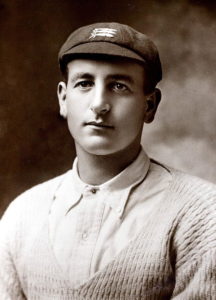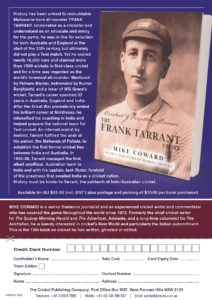Frank Tarrant was a pioneer of Indo-Oz cricket relations

Book Review
By Kersi Meher-Homji
Cricket’s Forgotten Pioneer ”“ The Frank Tarrant Story by Mike Coward, Cricket Publishing Company (cardwell@mcks.com.au), 104 pages, price $55 plus postage. Foreword by Harsha Bhogle.
This hard-cover beautifully presented book ”“ full of rare photos, autographs, official letters, cartoons and statistics ”“ is a must for every cricket lover in Australia and India.
You may well ask: Frank Tarrant who? He was a great Australian all-rounder who brought India and Australia together in cricket eight decades ago. His life story is fascinating as revealed by another India-loving Australian, Mike Coward.
I thought cricket’s biggest mystery was provided by Andy Ganteaume, the West Indies opening batsman. Despite scoring 112 runs in his Test debut against England in the 1948 Port-of-Spain Test, Ganteaume was never selected again and retired with a Test batting average of 112.00. But after reading Coward’s recent masterpiece I realize that Frank Tarrant being kept out of Test arena is even more mysterious.
The forgotten and talented all-rounder Tarrant (1880-1951) was a rare breed who should have played many Tests but was not selected in a single one.
Born in Melbourne, he shone out in first-class cricket for Victoria, Middlesex and for a few teams in India. In 329 first-class matches spanning 1898 to 1937 he scored 17,952 runs at an average of 36.41 with 33 centuries (highest score 250 not out for Middlesex against Sussex in 1914), took 1512 wickets at an average of 17.49 capturing 5 wickets in an innings 133 times (best being 10 for 90 for Lord Wellington’s XI against Maharajah of Cooch-Behar XI in 1918-19) as a left-arm spinner and held 303 catches. He umpired in India’s two Tests against England in Bombay and Calcutta in 1933-34.
A pioneer he brought Australia closer to India in cricket, playing cricket in India from 1915-16 to 1936-37. More significantly, he organised and managed the first Australian team to India in 1935-36 which played four unofficial tests. He was also responsible for laying turf at the Brabourne Stadium in Bombay.
To organise the tour to India he had an ongoing battle with the Australian Board of Control for Cricket but succeeded despite many knockbacks. The audacity of Tarrant to plan the tour to India angered the conventional Board members. They initially rejected the proposal but Tarrant persevered. Author of another classic book Cricket beyond the Bazaar (1990), Mike Coward researches deeply on how that unlikely tour became a reality.
Tarrant was in his best form as an all-rounder in 1908 when first invited to India as a cricket coach and consultant by Bhupinder Singh, the Maharaja of Patiala. The friendship grew, culminating in Australia’s historic tour of India in 1935-36.
Before the Maharaja of Patiala, Tarrant had befriended the legendary Ranjitsinhji when representing Marylebone Cricket Club (MCC) against London County at Crystal Palace in 1903. Tarrant never forgot the genius Ranji showed to engineer a most improbable victory for London County. As the author writes, “Tarrant’s prominence as a player had given him considerable social status and it can be reasoned Ranjitsinhji ensured Tarrant’s reputation quickly became well-known in India.”
Bhupinder Singh, the Maharaja of Patiala, was 17 when coached by Tarrant who was embraced by the royal household. Their friendship lasted till Bhupinder Singh passed away reportedly leaving behind 300 wives and concubines and 88 children.
The famous Indian commentator Harsha Bhogle writes in the Foreword, “”¦ this book casts light on a very interesting period in Indian cricket; full of romance, colour and patronage but equally of politics and subterfuge”¦ The orchards we see now emerged out of a sapling and Tarrant was in the middle of it all.”
Concludes the famous former Australian Test cricketer Paul Sheahan in the Afterword, “Full strength to Coward’s arm in accepting the challenge of doing justice to an Australian [Tarrant] who might be described as having been well ahead of his time.”
Mike Coward puts forward an interesting suggestion. He agrees that Allan Border and Sunil Gavaskar have every right to the Trophy which bears their names for Tests between Australia and India. “But indisputably Tarrant deserves greater recognition and a rarefied place in the game’s history.”
This fascinating book, published by the enterprising cricket personality Ronald Cardwell, was launched last week by Australia’s famous Test cricketer and captain Mark Taylor.

Short URL: https://indiandownunder.com.au/?p=15491
